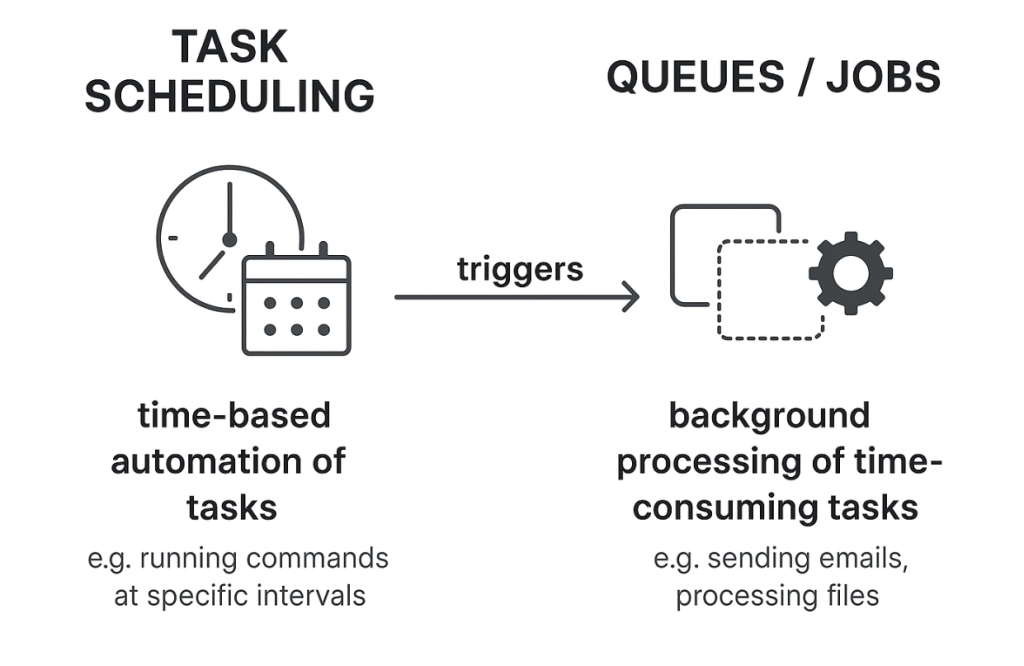While both task scheduling and jobs/queues in Laravel deal with executing tasks, they serve different primary purposes and operate differently.

Task Scheduling
- Purpose: Task scheduling is about when a task should run. It allows you to automate the execution of commands or operations at predefined intervals or specific times. Think of it as Laravel’s way of managing cron jobs within your application code .
- How it works: You define a schedule in your Laravel application (typically in
routes/console.phporapp/Console/Kernel.phpfor older versions) specifying which commands (Artisan commands, shell commands, or even invokable jobs) should run and how often (e.g., hourly, daily at a specific time, every five minutes). A single cron entry on your server then calls Laravel’sschedule:runcommand every minute, and Laravel determines which of your defined tasks are due to be executed. - Use Cases:
- Running routine maintenance tasks.
- Generating daily reports.
- Sending out scheduled newsletters.
- Fetching data from an external API at regular intervals.
Queues and Jobs
- Purpose: Queues are primarily about how a task is processed, specifically for deferring time-consuming operations to be handled in the background . This prevents long-running tasks from slowing down your web application’s response time to user requests . A “job” is the actual task or piece of work (like sending an email or processing a video) that you want to offload.
- How it works: When a task needs to be performed (often triggered by a user action), instead of executing it immediately, you dispatch a job to a queue. This job is then stored (e.g., in a database, Redis, or Amazon SQS) until a separate “worker” process picks it up and executes it asynchronously .
- Use Cases:
- Sending emails or notifications (which can involve external API calls with variable response times).
- Processing large file uploads (e.g., CSV imports) .
- Generating complex reports or data aggregations.
- Any task that could take a significant amount of time and negatively impact user experience if run synchronously during a web request .
Key Differences Summarized
| Feature | Task Scheduling | Queues & Jobs |
|---|---|---|
| Primary Goal | Automate tasks at specific times/intervals . | Defer long-running tasks for background processing. |
| Trigger | Time-based (cron). | Typically event-based (e.g., user action), or can be triggered by a scheduled task. |
| Execution | Can run tasks directly, or dispatch jobs to a queue. | Jobs are always processed asynchronously by workers . |
| Benefit | Automation, consistency. | Improved application responsiveness, better user experience, fault tolerance. |
| Mechanism | Defines a schedule of commands to run. | Pushes individual task objects (jobs) onto a queue for later processing. |
How They Work Together

Task scheduling and queues often work together effectively in Laravel:
- A scheduled task can be configured to run at a specific time.
- Instead of performing a long-running operation directly within the scheduled task (which could make the
schedule:runcommand itself take a long time), the scheduled task can dispatch a job (or multiple jobs) to a queue. - The queue workers will then pick up and process these jobs in the background.
Example Scenario:
- Task Scheduling: A task is scheduled to run every night at 2 AM to gather new user sign-up data.
- Dispatching to Queue: This scheduled task, instead of processing all sign-ups and sending welcome emails itself, dispatches an individual “SendWelcomeEmail” job to a queue for each new user.
- Queue Processing: Queue workers pick up these “SendWelcomeEmail” jobs and send the emails in the background, without delaying other scheduled tasks or impacting application performance.
In essence, task scheduling decides when to initiate a process, while queues decide how (and often where) a potentially lengthy part of that process is executed to maintain application performance.
Refrence:
- https://www.reddit.com/r/laravel/comments/q5ewup/queued_job_vs_scheduled_job/
- https://betterstack.com/community/guides/scaling-php/laravel-task-scheduling/
- https://laravel.com/docs/11.x/scheduling
- https://www.linkedin.com/pulse/cron-job-vs-queue-laravel-nouman-ali-ed9zf
- https://laravel.com/docs/12.x/queues
- https://laracasts.com/discuss/channels/laravel/queue-vs-schedule-performance
- https://stackoverflow.com/questions/68657463/laravel-task-scheduling-or-queue
- https://www.reddit.com/r/laravel/comments/a8ju08/task_scheduler_vs_job_queues_cron_vs_supervisord/
- https://stackoverflow.com/questions/71464442/laravel-scheduling-and-jobs-and-queues
- https://dev.to/snehalkadwe/task-scheduling-in-laravel-understand-the-power-of-cron-jobs-1140

I’m Abhishek, a DevOps, SRE, DevSecOps, and Cloud expert with a passion for sharing knowledge and real-world experiences. I’ve had the opportunity to work with Cotocus and continue to contribute to multiple platforms where I share insights across different domains:
-
DevOps School – Tech blogs and tutorials
-
Holiday Landmark – Travel stories and guides
-
Stocks Mantra – Stock market strategies and tips
-
My Medic Plus – Health and fitness guidance
-
TrueReviewNow – Honest product reviews
-
Wizbrand – SEO and digital tools for businesses
I’m also exploring the fascinating world of Quantum Computing.